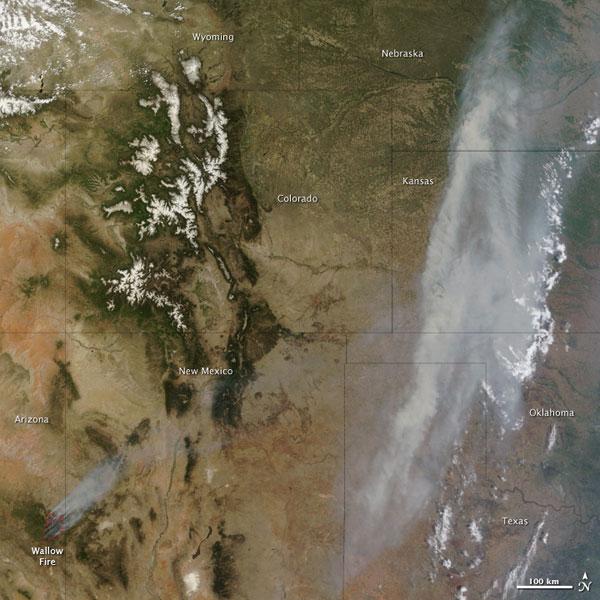Wild Facts About the Huge Arizona Wildfire


A roaring wildfire in Arizona has scorched nearly 500 square miles, making it the second-largest wildfire in the state's history.
The so-called Wallow Fire has yet to be even slightly contained despite firefighters constantly battling the blazes. Thousands of people have been forced to flee their homes and Gov. Jan Brewer has declared a state of emergency in two counties.
Here's what's behind this and other wildfires, and how this fire season stacks up in history:
How big is the Wallow Fire?
The fire has burned some 500 square miles (1,300 square kilometers, or 389,000 acres) — about 10 times the size of Manhattan in New York City.
How did the wildfires start?
The Arizona wildfire broke out in the Apache-Sitgreaves National Forest in Greenlee County on the afternoon of May 29.
Get the world’s most fascinating discoveries delivered straight to your inbox.
The cause of the fire is under investigation, but rumors quickly spread that the fires were intentionally set by illegal immigrants attempting to hide from Border Patrol agents.
What's the most common cause of wildfires?
Wildfires can start by natural causes or by human causes, such as arson. In the United States, lightning is a major cause of wildfires, and it has not been ruled out as a cause for the blazes in Arizona.
How do firefighters battle wildfires?
About 2,000 firefighters from across the country have joined forces to battle the Wallow Fire.
They use several methods, including so-called controlled burns, where firefighters try to choke the fire by burning off anything that could fuel it. Firefighters use torches at night to burn tinder and other fuel sources.
Other crews are digging around unburned areas to create "islands" free of fire-fueling vegetation to protect homes.
What fuels wildfires?
Critical factors that determine the end result of a wildfire include fuel, weather and terrain, according to the U.S. Fire Administration. Fuel includes live trees and grasses, along with dead branches on the ground, buildings and fences — anything that can burn.
Weather conditions that can keep a wildfire blazing include the current low humidity and drought conditions in the Southwest, which have hampered efforts to snuff the flames.
Winds can also spread a wildfire by helping the flames to jump between trees and other areas. The fire, and smoke, of the Wallow Fire has been spread by winds of up to 50 mph (80 kph).
How far has the smoke from the wildfire spread?
The smoke has drifted across several states, including Wyoming, Nebraska, Kansas, Oklahoma, Texas, Colorado and New Mexico. Smoke has even been reported as far east as Iowa and the U.S. Air Quality "Smog Blog" said that smoke from the Wallow Fire pushed air quality to unhealthy levels as far east as Alabama and Georgia.
Smoke from wildfires is a mixture of gases and fine particles from burning trees and other plant materials. Smoke can hurt your eyes, irritate your respiratory system, and worsen chronic heart and lung diseases, according to the Centers for Disease Control and Prevention.
What states/regions are most prone to wildfires?
Wildfires can strike nearly anywhere in the United States, but western states are most prone to wildfires. Recently, California and Texas have battled historic blazes. Western states have an extremely long dry season (May to January) that provides ample fuel for wildfires.
What is Arizona's biggest wildfire on record?
The Rodeo-Chediski fire in eastern Arizona burned nearly 733 square miles (469,000 acres) in 2002.
What are some historically "big" wildfires in the United States?
Some of the biggest wildfires in history include:
- Great Fire (Oregon, 1845): 1.5 million acres burned.
- Peshtigo (Wisconsin and Michigan, 1871): more than 3.5 million acres burned, 1,500 lives lost in Wisconsin
- Great Idaho (Idaho and Montana, August 1910): 3 million acres burned, and nearly 90 lives lost
- Laguna (California, September 1970): more than 175,000 acres burned and nearly 400 structures destroyed
- Yellowstone (Montana and Idaho, 1988): more than 1.5 million acres burned
- Dunn Glen Complex (Nevada, August 1999): nearly 290,000 acres burned and the largest fire of the year
- Cedar Fire (California, October 2003): About 275,000 acres burned, 2,400 structures destroyed and 15 lives lost
- Murphy Complex (Idaho, July 2007): more than 650,000 acres burned
Is climate change to blame for this wildfire?
Scientists can't link a single wildfire (or any natural disaster) to global warming.
That said, many scientists speculate that in a warming world the likelihood of wildfires in arid and semi-arid regions such as the Southwest is higher. That's because the two main ingredients that increase the likelihood of wildfires — hot temperatures and dry conditions — are expected to increase in a warming world. Over the next 90 years, scientists say the southwestern United States and parts of northern Mexico will experience nearly perpetual drought.



